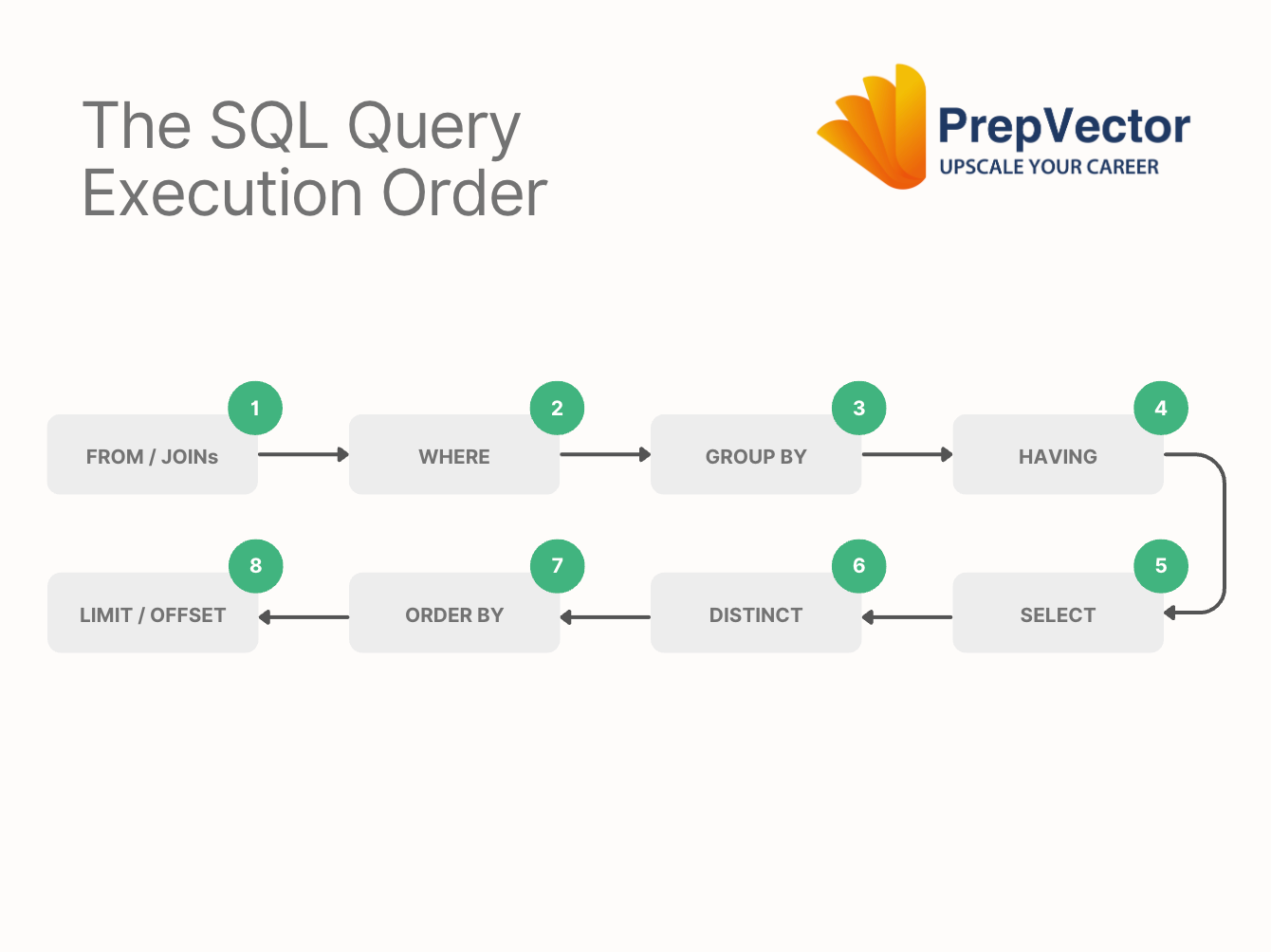Understanding SQL Query Execution Order: A Behind-the-Scenes Look
SQL query execution order is different from how the query is written! We explore behind-the-scenes operations that shape how your SQL queries are executed, so you can write performance-optimized query
👋 Hey! This is Manisha Arora from PrepVector. Welcome to the Tech Growth Series, a newsletter that aims to bridge the gap between academic knowledge and practical aspects of data science. My goal is to simplify complicated data concepts, share my perspectives on the latest trends, and share my learnings from building and leading data teams.
Hello SQL Enthusiasts,
Welcome to another edition of SQL Insights! Last time, we explored SQL Joins, analyzing various techniques to merge datasets. This week, we’re diving into another critical skill for every data professional—SQL Execution Order.
These posts are part of the larger Learn Data Science with Me initiative, a collaboration between Manisha Arora, Sai Kumar Bysani, and Siddarth R. Together, we’re creating a community-driven learning experience designed for professionals who want to deepen their data science expertise.
What is the Learn Data Science with Me Initiative?
I’ve set a personal goal to upskill 1,000 data professionals in 3 months, and I’m thrilled to have you join this journey. It’s all about building practical skills, engaging with thought leaders, and tackling real-world challenges together.
This initiative will be an immersive learning experience focused on industry learnings, skills, and use-cases. Here’s what you can expect:
✅ Coding Challenges: Practical SQL, Python, and ML problems to sharpen your problem-solving skills
✅ Paper Reading Sessions: Discussions on cutting-edge research papers and blogs to bridge theory and practice
✅ Speaker Sessions: Interactive Q&A and deep dives into trending industry topics
✅ AMA Discussions: Open forums for real-time learning and insights
The 15-day SQL Challenge, launching in March, is the first structured challenge of the series! If you enjoyed this week’s aggregation-focused content, get ready for what’s next. The challenge will cover everything from writing efficient queries to mastering advanced SQL optimizations, ensuring you build a strong foundation in SQL.
The SQL Query Execution Order
When you run a query, SQL doesn’t process it in the order it appears in the query. Instead, it follows a specific sequence:
Let’s Break It Down
Here’s a sample query to illustrate the process:
SELECT name, AVG(salary) AS avg_salary
FROM employees
WHERE department = 'Sales'
GROUP BY name
HAVING AVG(salary) > 50000
ORDER BY avg_salary DESC
LIMIT 10;Now, let’s walk through the execution order of this query:
FROM / JOINs
SQL begins by looking at the employees table, pulling in all relevant data. If there were any joins, this is where SQL would combine data from multiple tables.WHERE
Next, SQL filters the data using the WHERE clause. In this case, only employees in the 'Sales' department will be considered.GROUP BY
After filtering, SQL groups the data by name, since we want to compute the average salary per employee.HAVING
SQL then applies the HAVING clause to filter out any groups where the average salary is not greater than 50,000.SELECT
At this stage, SQL returns the columns specified in the SELECT clause. It calculates the average salary for each name.DISTINCT
If you had a DISTINCT keyword in your query, it would now remove duplicate rows from the results.ORDER BY
SQL will now order the results by avg_salary in descending order, as specified in the ORDER BY clause.LIMIT / OFFSET
Finally, SQL applies any LIMIT or OFFSET values. In this case, it will return the top 10 employees with the highest average salary.
Pro Tips for Query Execution Order
Understanding the Order: Always remember that SQL processes your query logically from FROM to LIMIT. Even if you write your query in a different order, SQL will follow this logical sequence.
Avoid Complex Queries: Breaking down complex queries into smaller, more manageable parts can help with debugging and optimization. Consider using CTEs (Common Table Expressions) or subqueries for better clarity.
Use EXPLAIN for Performance: Use EXPLAIN (or EXPLAIN ANALYZE in some databases) to visualize the query execution plan and identify potential bottlenecks. This can help you optimize queries, especially when dealing with large datasets.
Example: Optimizing Query Execution
Let’s say you have the following query:
SELECT name, COUNT(*) AS order_count
FROM customers
JOIN orders ON customers.id = orders.customer_id
WHERE orders.amount > 100
GROUP BY name
HAVING COUNT(*) > 5
ORDER BY order_count DESC;The query might seem straightforward, but if orders is a large table, this could take time to process. Here’s a smart way to optimize it:
Filter Early: Apply the WHERE clause before the join to reduce the number of rows being processed:
SELECT name, COUNT(*) AS order_count
FROM customers
JOIN (SELECT * FROM orders WHERE amount > 100) AS orders_filtered
ON customers.id = orders_filtered.customer_id
GROUP BY name
HAVING COUNT(*) > 5
ORDER BY order_count DESC;By filtering the orders table first, we reduce the data passed to the JOIN operation, improving query performance.
Understanding SQL's query execution order is a game-changer for writing more efficient queries and troubleshooting slow performance. Next time you write a query, keep the execution order in mind to ensure you're using the most efficient sequence for your operations.
🔥Exciting Announcement: The 15-Day SQL Challenge!
Are you ready to test your SQL skills and take them to the next level? We’re excited to announce our 15-Day SQL Challenge, which kicks off in March! Here’s how it works:
One question per day for 15 days: You’ll receive a daily SQL problem, ranging from beginner to advanced topics, to help you sharpen your skills.
Leaderboard: Track your progress and compare your performance with others on the leaderboard!
Rewards: Those who complete the challenge will receive exciting rewards and recognition.
This is the perfect opportunity to challenge yourself, compete with your peers, and grow your SQL knowledge!
Button: Register for the SQL Challenge!
Don’t miss out! The challenge is going to be a blast. Let’s get ready to level up your SQL skills together!
🚀 Join Our Data Science Community!
Become a part of the Learn Data Science with Me community and connect with fellow professionals on the same journey. Get access to exclusive content, participate in interactive discussions, and stay updated on challenges, speaker events, and more. Join us today and accelerate your learning with a supportive network of data science enthusiasts!
That’s it for this week’s edition of SQL Insights!
Next edition, we’ll dive into window functions, which will take your SQL skills to the next level. Stay tuned and happy querying!






